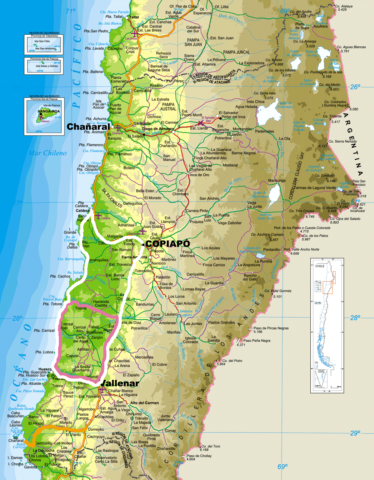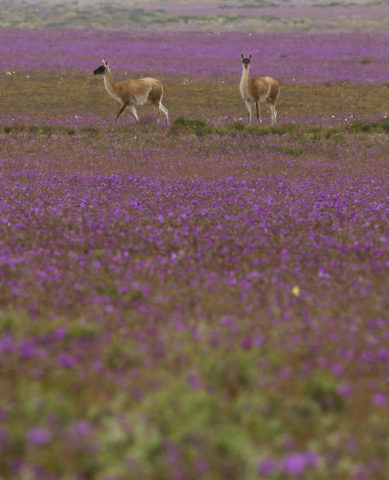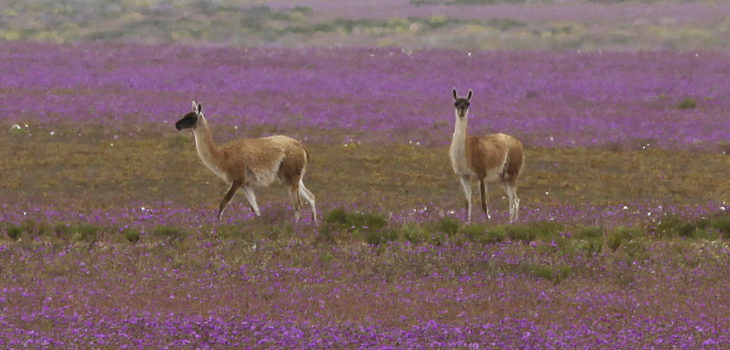The Chilean flowering desert is currently experiencing the final period of its peak, which is estimated to come to an end right after the 18 September national celebrations. After that, the phenomenon will start to fade away, a process that is vital to ensure future bloomings.
If you have not visited it yet and you wish to, or if you are making your way to the area soon, you still have time to enjoy this rare natural spectacle.
In this article, you will find the dos and dont’s should you visit the Atacama region -Chile’s third- where to go, pundits’ comments and more.
What is and what causes a flowering desert?
This phenomenon literally produces what its name says: flowers in a desertic area.
However, and even though Atacama is the driest non-polar desert on earth, it does get rain from time to time.
If those exceed the 15 milimiter mark (0,59 inches), this will make dormant seeds germinate, confirmed in conversation with BioBioChile (BBCL) the head of the Biological Diversity Conservation Section of Atacama’s National Forest Corporation (Conaf), César Pizarro, as well as the head of the Department of Botany at the National Museum of Natural History (MNHN), Gloria Rojas.
Given that precipitations during May and June in the Huasco province added up to 65 milimiters (2,55 inches), according to the pluviometer at the Llanos de Challe National Reservoir, this led to the explosive flowering which currently adorns the usually dry and rough landscapes of the north of Chile, Pizarro said.
Con mucha humildad envió este, mi primer video del comienzo del desierto florido @RichardBezzaza @PANCHOSAAVEDRA @peponatalia @davidfractal pic.twitter.com/93HbsyRMNs
— AlEjandro PimEntEl (@AlejandroPime13) 16 de agosto de 2017
In Rojas’ words, she described this phenomenon as “a massive flowering over an area of extreme dryness, which occurs from time to time in the Atacama desert”.
This produces “a colorful event of extraordinary beauty when it rains in the desert”.
“The rain comes to the area every few years. Sometimes more often, some others not as much”, Rojas added.
Añañucas rojas del desierto de Atacama #desiertoflorido #huasco #freirina #Chile #naturaleza #nikond3300 #nikon pic.twitter.com/KZXF0B1lYG
— Elizabeth Vega Díaz (@makitavegadiaz) 15 de septiembre de 2017
These unusual precipitations are closely related to El Niño, specially when it gets pushed to the far north of Chile, Rojas detailed.
The current blooming’s peak started during the third week of August, with coastal areas such as Huasco, Caldera and the Llanos National Reservoir concentrating the blooming. Nonetheless, inland areas between Vallenar and Copiapó also bloomed.
But if it is a desert, why are there flowers there?
“Because their origin is very old. Many have a tropical origin, some others come from desertic coastal areas in Perú. When they ended being isolated, they evolved into different species from their ‘ancesters’“, Rojas pointed out.
The flowers that at present adorn the third region, as well as a part of the fourth region, are those who answer better to rainfall, particularly dormant seeds like bulbs and bushes.
Unreal colors – Desierto de Atacama
Una publicación compartida por ELISE CLOETENS (@elisecloetens) el
In this way, Pizarro urges visitors and local folk to visit and explore the area responsibly, as “the vast majority of the flora only exists here, they are unique on Earth”.
“So cutting flowers means deducting seeds to ensure the continuity of the flora in the future, specially during a period where the rythm of extinction is accelerated as an effect of global warming, which is worsened by humans and the pressure we put on soil, forests, rivers and oceans, which only affects negatively the natural components of the planet”, Pizarro stated.
Incroyable #desiertoflorido au #Chili ! pic.twitter.com/lOaSxNHcyZ
— Claire Bertin (@claire_bertin) 15 de septiembre de 2017
Where to go?
If you make your way to the Atacama region, from Conaf’s local branch advised to get to know the distances beforehand as well as the approximate lenght of a journey, since “areas in the north are larger than expected, and sightseeing points are quite numerous”.
Hence, those interested in observing large flower stretches should take “the C-500 route, which links Domeiko and Caleta Chañaral in the southern area of the third region, where you can usually see, at first, trumpet vines and then patas de guanaco.
Another option is Ruta 5 Norte, route that links Vallenar and Copiapó where, since the end of August, pink flowers have colored the landscape. For a similar experience, you can travel alongside the C-416, route that links Caleta Totoral to Ruta 5 Norte.
Finally, the coastal road that links Huasco and Bahía Inglesa is ideal to enjoy and observe white, yellow, orange and violet flowers.
Conaf Atacama made clear that if you are interested in seeing homogeneus streches of color, you must visit inland areas of the third region. On the other hand, if a mixture of color is what you are after, then you should make your way to the coast, as close to the sea as possible.

The National Tourism Service (Sernatur) also advised to visit the Llanos de Challe National Reservoir.
Protecting the environment
The local branch of Sernatur led fierce campaigns to make people aware of the importance of looking after the environment as well as protecting both the flora and the fauna.
“Basically, the tips we -as Sernatur-, give, not only for turists, but also for local communities regard being a responsible viewer”, said the coordinator of Sernatur Atacama’s Touristic Information Office, Evelyn Gerónimo. Those are:
1. Respect signaled trails. Do not walk outside them.
2. You can enjoy the blooming on the road, stop only at established viewpoints and drive safely.
3. Do not step/walk on the flowers, let alone cut them as they will not be able to finish their process successfully.
4. Do not remove tubers/plants/flowers, as these species only grow in this area. They are endemic.
5. If you take any pets, be responsible.
6. Do not feed, capture not harm local fauna.
Take care of the native vegetation, it is home to a number of fragile animal species that need our respect and protection.

Tour operators
Before the peak started, local tour operators saw an increase of 40% in the number of flowering-desert-related inquiries.
Towards the end of July, the influx of turists registered an increase of 25% in comparison to the same period in 2016, entirely due to the start of the blooming in the Atacama region.
In conversation with BBCL, Gerónimo emphatically asked those interested in visiting the area to only hire/buy official tour services registered by Sernatur, as they are “formal, trustworthy businesses, which give clients safety and professionalism when it comes to spending money to enjoy the phenomenon”.
Sernatur expects 25 thousand tourists will have made their way to the north by the end of this year’s blooming.
Flowering desert and social media
People have shared their experiences on social media. When will you share yours?
If your pictures appear in this article and you wish they would not, do send an email to elara@biobiochile.cl or info@biobiochile.cl and we will gladly remove them from the site.
📷: lo que me manda mi papá del desierto 🌵#nofilter
Una publicación compartida por Josefina Sone. (@josefinasone) el
Para proteger el #DesiertoFlorido, ley SBAP ahora ya! pic.twitter.com/9Eizgkuzgz
— Juan Luis Celis Diez (@juanluiscelis) 15 de septiembre de 2017
Una publicación compartida por Danni Stonem🌸 (@_wind.rose_) el
Ya no debería sorprenderme 😟 #photography #desiertoflorido
Una publicación compartida por ⠀ ⠀⠀ ⠀⠀ ⠀ ⠀ ⠀ Ivonne L.F. (@on.theroad) el
Quería compartir mi vídeo: flores, desierto, el canto de los pájaros, el viento y la música del auto.
Desierto florido, 12 septiembre 2017. pic.twitter.com/pAJQrs2jrF— Jorgito 🍀 (@jvillalobosa) 15 de septiembre de 2017
El desierto florido es un estallido de colores y vida que quise retratar.
Tuve la suerte de tener un día nublado c… https://t.co/g7bXq4mo1E pic.twitter.com/YDSaaHf8Jj— Paulo Olivier H. (@elFotoAndinista) 14 de septiembre de 2017
Ruta 5 altura Vallenar. #desiertoflorido #chile #photography #nortedechile #nature #naturaleza
Una publicación compartida por Pia Vergara (@piavergarafotografia) el







 Enviando corrección, espere un momento...
Enviando corrección, espere un momento...





